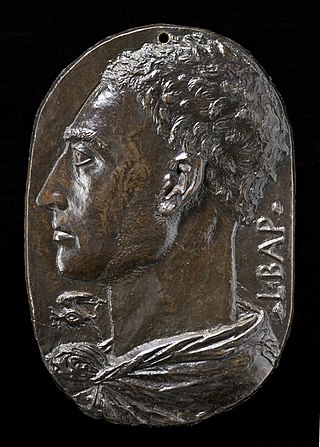
Leon Battista Alberti was an Italian Renaissance humanist author, artist, architect, poet, priest, linguist, philosopher, and cryptographer; he epitomised the nature of those identified now as polymaths. He is considered the founder of Western cryptography, a claim he shares with Johannes Trithemius.

The province of Lucca is a province in the Tuscany region of Italy. Its capital is the city of Lucca.

A groin vault or groined vault is produced by the intersection at right angles of two barrel vaults. The word "groin" refers to the edge between the intersecting vaults. Sometimes the arches of groin vaults are pointed instead of round. In comparison with a barrel vault, a groin vault provides good economies of material and labor. The thrust is concentrated along the groins or arrises, so the vault need only be abutted at its four corners.
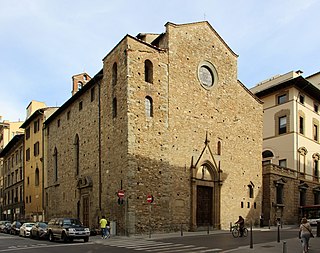
Santa Maria Maggiore di Firenze is a Romanesque and Gothic-style, Roman Catholic church in Florence, region of Tuscany, Italy. This is among the oldest extant churches in Florence.
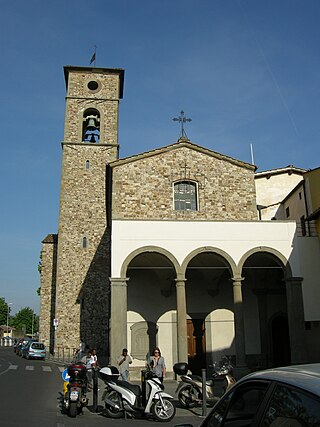
San Salvi, also known as San Michele a San Salvi, is a church in Florence, Italy.
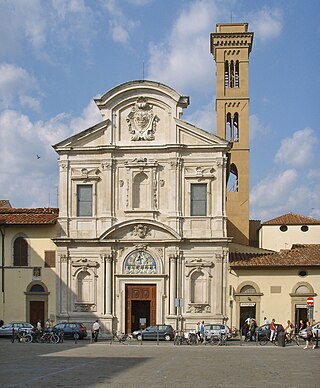
The chiesa di San Salvatore di Ognissanti, or more simply chiesa di Ognissanti, is a Franciscan church located on the piazza of the same name in central Florence, region of Tuscany, Italy. Founded by the lay order of the Umiliati, the church was dedicated to all the saints and martyrs, known and unknown.

San Michele Visdomini is a Roman Catholic church in the centre of Florence, central Italy. The original church of San Michele was demolished in 1368 to make space for the tribunes of the new Cathedral of Florence. Soon it was rebuilt in its present location to a design by Giovanni di Lapo Ghini, with later facade (1577-1590) by Bartolomeo Ammannati. A chapel for Francesco Pucci houses a Holy Family and Saints by Jacopo Pontormo.
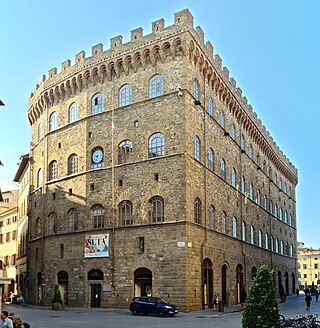
Palazzo Spini Ferroni is a large Gothic palace located along Via de' Tornabuoni at the corner of Piazza Santa Trinita, in central Florence, Tuscany, Italy. It stands across from the church of Santa Trinita.

Sant'Apollonia was a former Benedictine convent, founded in 1339, just north of the center of Florence, in Italy.

Piazza della Repubblica is a city square in Florence, Italy. It was originally the site of the city's forum; then of its old ghetto, which was swept away during the improvement works, or Risanamento, initiated during the brief period when Florence was the capital of a reunited Italy—work that also created the city's avenues and boulevards. At that time, the Loggia del Pesce from the Mercato Vecchio was also moved to Piazza Ciompi. The square's Giubbe Rosse cafe has long been a meeting place for famous artists and writers, notably those of Futurism.
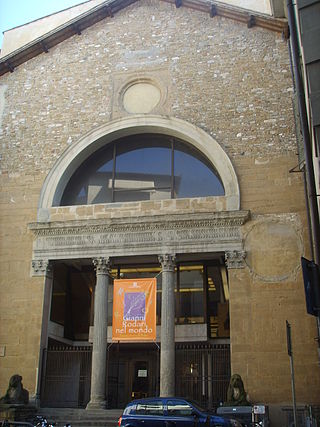
San Pancrazio is a church in Florence, Italy, in Piazza San Pancrazio, behind Palazzo Rucellai. With the exception of the Rucellai Chapel, it is deconsecrated and is home to the museum dedicated to the sculptor Marino Marini. The Rucellai Chapel contains the Rucellai Sepulchre or Tempietto del Santo Sepolcro. Since February 2013 it has been possible to visit the chapel from within the Marini museum.
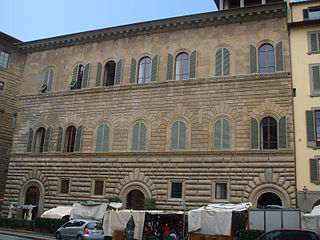
Palazzo Gondi is a palace in Florence, Italy, located a block from Piazza della Signoria. It was built in 1490 under design by Giuliano da Sangallo, who was inspired by other major works of stately buildings in the city, such as Palazzo Medici and Palazzo Strozzi. Among the elements borrowed from these earlier works are the cube-shape set around a central courtyard, the ashlar sloping on each of three floors, and the arched windows.
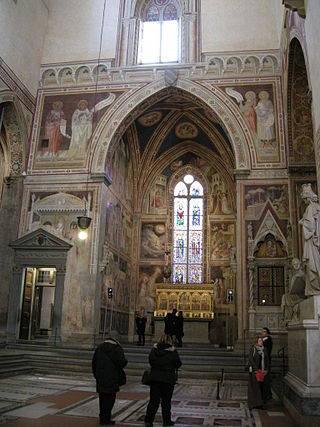
The Baroncelli Chapel is a chapel located at the end of the right transept in church of Santa Croce, central Florence, Italy.

The Torre degli Alberti is a XIII century medieval tower in Florence, Italy. It has a polygonal plan and was the headquarters and residence of the Alberti, one of the most numerous and powerful families in the medieval Florence.
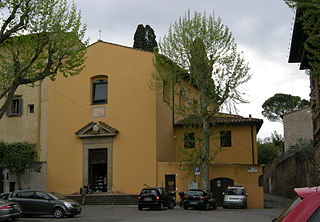
San Francesco di Paola is a small Renaissance-style Roman Catholic church in the Oltrarno quarter of Florence, central Italy.

The Triumphal Arch of the Lorraine located in Piazza della Libertà in Florence, Italy, is an 18th-century, monumental triumphal arch, bypassed by the viali di Circonvallazione that skirt Florence through the space once girded by its 16th-century walls. The piazza stands at the northernmost end of Via Cavour, Florence, region of Tuscany, Italy.

The Porta Romana, once known as the Porta San Pier Gattolino was the southernmost gate in the 13th-century walls of the Oltrarno section of Florence, region of Tuscany, Italy. It stands at the confluence of a number of roads: accessed from north by Via Romana, Via de' Serragli, and Viale Francesco Petrarca. In addition, a central road along the Boboli Gardens begins near the gate, and allowed the inhabitants of the Pitti Palace to exit and enter Florence with minimal travel on city streets. Beyond the gates are the Via del Poggio Imperiale and Via Senese. The latter led to Siena and points south such as Rome, hence the name. When the majority of the defensive walls of Florence were razed in the 19th century, only a few, and sometimes partial gate structures were left standing including San Gallo Gate, Tower of San Niccolò, and this gate with a snippet of merlonated wall.
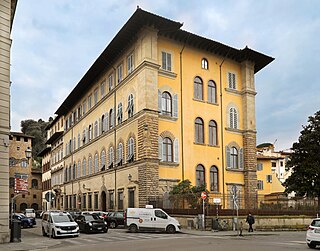
The Palazzo Torrigiani Del Nero is a Renaissance-style palace located at Piazza de' Mozzi 5, down the street where the Ponte alle Grazie enters the Oltrarno in Florence, Tuscany, Italy. Another Palazzo Torrigiani stands alongside, the smaller Palazzo Nasi. Both palaces also once belonged to the Nasi.

Church of the Nativity of Christ and St. Nicholas the Wonderworker is a Russian Orthodox church in Florence, located on via Leone X, near the Basso Fortress. Its style is a late 19th and early 20th century imitation of the earlier Naryshkin Baroque.




















